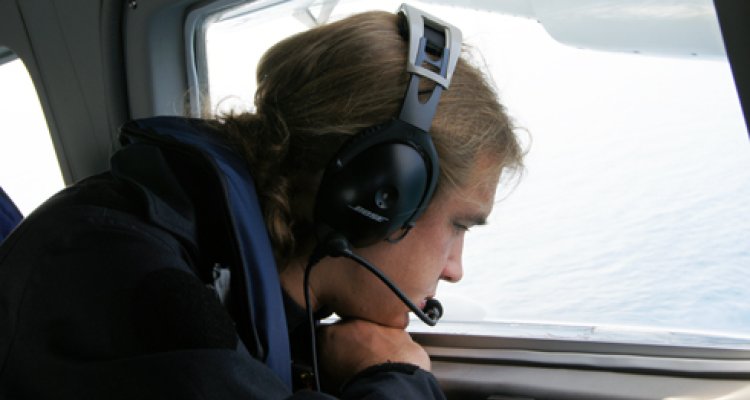
Aerial surveys of harbour porpoises
Wageningen Marine Research is an expert in aerial surveys of harbour porpoises. These surveys are conducted to make abundance estimates of the harbour porpoise population in the Dutch North Sea. The data of these surveys are used to determine the effects of the construction of wind farms, industrial developments or other projects.
Wageningen Marine Research has experience in aerial surveys of harbour porpoises. Aerial surveys are conducted with a high-winged, double-engined airplane with bubble windows, ensuring the two observers have a good view of the area below the plane. A third person enters the collected data on marine mammal sightings and environmental conditions in real time.
Sighting left... porpoise, angle six two, cue body at surface, swimming direction one one zero, reaction no, dive no, normal swim
The plane flies at a fixed altitude of 600 ft (183 m). Surveys are conducted with a seastate of 3 Beaufort or less. Surveys are conducted using line transect distance sampling methods along pre-designed track lines allowing a representative coverage of the study area. To compensate for missed animals perpendicular distances to observed animals are measured and the so-called racetrack method is used. This means that the airplane circles back once an observation is made to determine if the animal is seen again.
Data from aerial surveys are used for abundance estimates on the Dutch Continental Shelf, and – on a smaller scale- to assess effects of for instance offshore wind farms, construction activities in harbours or other anthropogenic activities. Compared to ship-based surveys, aerial surveys have the advantage that porpoises cannot avoid the survey vessel before they are detected. Elusive harbour porpoises are easier to detect from the air than from a ship. Finally, in the same survey time an airplane can cover larger areas than a ship.
Employees of Wageningen Marine Research are experienced in distance sampling methods, and give aerial survey training themselves. They have experience in modelling porpoise distribution. Wageningen Marine Research does the maintenance of the Dutch database with marine mammal survey data.
Publications
-
Distribution maps of cetacean and seabird populations in the North‐East Atlantic
Journal of Applied Ecology (2020), Volume: 57, Issue: 2 - ISSN 0021-8901 - p. 253-269. -
Abundance of harbour porpoises (Phocoena phocoena) on the Dutch Continental Shelf, aerial surveys 2012-2017
Lutra (2018), Volume: 61 - ISSN 0024-7634 - p. 127-136. -
Seasonal habitat-based density models for a marine top predator, the harbor porpoise, in a dynamic environment
Ecosphere (2016), Volume: 7, Issue: 6 - ISSN 2150-8925 -
Abundance of harbour porpoises (Phocoena phocoena) on the Dutch Continental Shelf, aerial surveys in July 2010 - March 2011
Lutra (2013), Volume: 56, Issue: 1 - ISSN 0024-7634 - p. 45-57. -
Using aerial surveys to estimate density and distribution of harbour porpoises in Dutch waters
Journal of Sea Research (2012), Volume: 69 - ISSN 1385-1101 - p. 1-7.
Reports
-
Marine mammal surveys in Dutch waters in 2012
Den Burg: IMARES (Report / IMARES Wageningen UR C038/13) -
Shortlist Masterplan wind Aerial surveys of harbour popoises on the Dutch Continental Shelf
Den Helder: IMARES (Report / IMARES Wageningen UR C103/11) -
Distribution and density of harbour popoises in Dutch North Sea waters
Texel: IMARES (Report / Wageningen IMARES nr. C125/09)